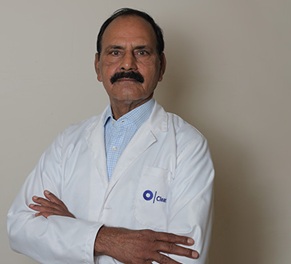Ventral Hernia Surgery - Procedure, Benefits and Recovery

Treatment Duration
2 Hours
------ To ------3 Hours
Treatment Cost
₹ 50,000
------ To ------₹ 1,80,000

Table of Contents
- What is Ventral Hernia Surgery?
- Conditions treated with Ventral Hernia Surgery
- Who needs Ventral Hernia Surgery?
- How is Ventral Hernia Surgery performed?
- What to expect before and on the day of Ventral Hernia Surgery?
- What to expect after Ventral Hernia Surgery?
- Benefits of Ventral Hernia Surgery
- Risks and complications of Ventral Hernia Surgery
- Risks of delayed Ventral Hernia Surgery
- Cost of Ventral Hernia Surgery
Ventral Hernia Surgery is a surgical method to treat ventral hernia, a condition that causes a bulge in the skin of the abdominal area. This procedure is also known as Ventral Hernioplasty.
Ventral hernia surgery is a safe procedure that usually takes about 2 to 3 hours to complete. The recovery after the surgery is generally quick and effortless.
| Surgery Name | Ventral Hernia Surgery |
| Alternative Name | Ventral Hernioplasty |
| Diseases Treated | Ventral Hernia, Epigastric hernia, Umbilical hernia, Incisional hernia |
| Benefits of the Surgery | Remove any bulge or lump, Prevent complications, Help reduce pain and discomfort |
| Treated by | General Surgeon |
You can check Ventral Hernia Surgery (Ventral Hernioplasty) Cost here.
What is Ventral Hernia Surgery?
Ventral Hernia Surgery is a surgical method to treat ventral hernia, a condition that causes a bulge in the skin of the abdominal area. This surgical procedure is also known as Ventral Hernioplasty. This procedure restores the shape of the abdominal wall and prevents the bulging of the intestines through the hole in the abdominal muscles.
Anatomy and Physiology of Abdomen
- The abdomen is an area between your chest and pelvis.
- The wall of the abdomen consists of various layers such as skin, muscles, and fascia. These layers help in protecting your internal organs.
- The muscles present in the abdomen contribute to the trunk (central part of your body) movements.
Ventral Hernia Surgery (Ventral Hernioplasty) Videos by HexaHealth
Expert Doctors (10)
NABH Accredited Hospitals (10)
Ventral Hernia Surgery (Ventral Hernioplasty) Success Stories


Conditions treated with Ventral Hernia Surgery
Ventral hernia surgery is mainly considered when the patient has a ventral hernia condition. This procedure helps treat ventral hernia that can develop in either of the three locations:
- Epigastric hernia: Below the breastbone to the belly button
- Umbilical hernia: In the area of the belly button
- Incisional hernia: At the previous surgical site
Who needs Ventral Hernia Surgery?
Ventral hernia surgery is recommended for patients with a ventral hernia as this condition cannot heal on its own. Ventral hernia can appear as a congenital defect at birth or develop over a period resulting from factors such as pregnancy, abdominal surgery, or long-term stress on the abdominal muscles.
How is Ventral Hernia Surgery performed?
Ventral hernia surgery is generally performed under anaesthesia (local or general) based on the severity of the hernia. The procedure usually takes 2 to 3 hours to complete depending on the patient’s age, other comorbidities and the severity of the condition. The following steps are involved in the procedure:
- On the operating table, the patient will be asked to be in a supine position (lying down horizontally with your face up).
- The hair on the surgical site will be shaved, and then the skin layer is made sterile (free of germs) using an antimicrobial agent.
- Except for the abdominal region where the surgeon will carry out the surgery, all the other body parts will be draped or covered with a sterile sheet that helps maintain an area free of microorganisms during surgery.
- The anesthesiologist will continuously monitor the vitals during the surgery, such as pulse rate, blood pressure, and breathing.
- The anesthesiologist will then administer general anaesthesia to make the patient comfortable during the surgery.
Ventral hernia surgery can be conducted by the following types of surgical techniques:
- Open repair procedure:
- In open repair surgery, the operating surgeon will
- Make a large cut in the groin area (between the upper thigh and lower abdomen) and identify the part of the intestine bulging out.
- Push back this part of the intestine inside the abdomen.
- Join the abdominal muscles by either stitching or using hernia mesh.
- Stitching is done by joining the edges of the muscles; however, it is preferred in smaller hernias that were present right from birth or if the stitching is possible without causing too much pressure on the tissue.
- Mesh will be widely used, especially if a patient has a hernia of a bigger size. Mesh reduces the chances of getting a hernia again.
- In open repair surgery, the operating surgeon will
- Laparoscopic repair procedure:
- The laparoscopic procedure, also called keyhole surgery, is a minimally invasive surgery (requiring minimal incisions or cuts). During this surgery, the surgeon will:
- Make several minor cuts on the belly button.
- Insert a thin telescope called a laparoscope through the cut. A camera is attached to the laparoscope, which helps the surgeon view your body from the inside. The surgeon will be able to see two-dimensional images of the internal body on a television screen inside the operating room.
- Inflate the abdominal area with carbon dioxide gas. This gas is harmless for the body and will help the surgeon observe the internal body structure and return the intestinal part or fatty tissue to its place.
- Cut the inner layer of the abdomen. This will help the surgeon to view the abdominal muscle with a hole in it.
- Removes the inflated gas after the intestine or fatty tissue is placed back in its original place.
- Seal the exposed muscle using a hernia mesh. This will also help to strengthen the muscular layer.
- Seal the small incision with surgical tape, staples, or stitches.
- The laparoscopic procedure, also called keyhole surgery, is a minimally invasive surgery (requiring minimal incisions or cuts). During this surgery, the surgeon will:
- Robotic repair procedure:
- The majority of the procedure for robotic repair is similar to that of the laparoscopic approach. A few differences between robotic repair from laparoscopic repair are:
- The operating surgeon will remain seated at the console and handle all the instruments required for the surgery from that console.
- The robot used during the surgery will generate three-dimensional images of good quality.
- The use of stitches or mesh during the surgery becomes much easier.
- The majority of the procedure for robotic repair is similar to that of the laparoscopic approach. A few differences between robotic repair from laparoscopic repair are:
What to expect before and on the day of Ventral Hernia Surgery?
Before undergoing ventral hernia surgery, the doctor/surgeon will discuss and prepare the patient for the surgery. These steps often involve:
Before Ventral Hernia Surgery
Before undergoing the ventral hernia procedure, the doctor will:
- Conduct a physical check-up.
- Ask about the medical history of the patient.
- Recommend specific tests like ultrasound scan or computed tomography (CT) scan. This will help the operating surgeon understand the hernia better.
- Recommend blood tests, chest x-ray, and electrocardiography. The surgeon will decide to carry out these tests based on the age and health condition of the patient.
- Choose a specific type of ventral hernioplasty depending on the following:
- The size of the ventral hernia.
- Age of the patient.
- Existing health problems or infection.
- Medical history of the patient
- Previous surgical attempt for a hernia.
- Depending on the results obtained from the health check-up, the surgeon will decide the surgery date.
- The patient will know when the hernioplasty will be scheduled and when he/she should reach the hospital before the surgery.
On the day of Ventral Hernia Surgery
- The patient must arrive at the hospital two hours before the surgery.
- Once the patient arrives at the hospital on the day of the surgery, the patient will meet someone from the healthcare staff who will:
- Ask the patient to sign a consent form.
- Apart from a surgical gown, the patient will also be asked to wear stockings. Stockings will help to reduce the risk of blood clotting in the legs due to surgery.
- The healthcare staff will ask the patient to urinate right before the surgery.
- If the patient is using any prescription medications, the surgeon will advise him/her to take the medicines with a small sip of water.
- A nurse will place an intravenous catheter in the patient’s hand or forearm, and then general anaesthesia will be administered.
- The patient will be shifted to the operation theatre for the procedure.
What to expect after Ventral Hernia Surgery?
A patient who has undergone ventral hernia surgery can expect the following after the surgery:
The recovery process at the hospital
- In the recovery room, the patient will have an oxygen mask placed on his/her face to ease breathing after surgery.
- The healthcare staff will continuously monitor all of the patient's vitals, like blood pressure and pulse rate.
- The patient will also have an intravenous line attached to the arm, which will pass on nutrients in the body. The intravenous line will be attached until the patient can eat and drink on their own.
- The patient may feel like vomiting due to the anaesthetic medication. For this, the healthcare staff may provide the patient with medication to ease the condition.
- The patient might notice an abdominal corset or binder placed on the surgical site. This will help to support the abdominal area after the surgery.
- The healthcare staff will shift the patient to the ward once he/she is fully awake and the condition is stable.
- The healthcare staff will ask the patient to stand up and move after some time. This will help the patient to lower the risk of complications that can occur after hernioplasty.
- During surgery, the surgeon will remove the inflated carbon dioxide gas; however, some amount of gas might remain inside, leading to discomfort at the shoulder tip and abdominal area. The surgeon may recommend the patient change positions and use painkillers in such cases.
- The patient will be discharged on the same day once the condition is stable after surgery.
- The patient might also need to spend a night depending on various factors like the time of surgery, the home care situation, recovery time, and complications (if any).
- The patient would not be able to drive immediately after surgery; hence, the patient will need someone to drop him/her at home post-discharge.
- Someone from the family or friend must stay with the patient for at least one day after discharge.
Recovery process/expectation after hospital discharge
- All the instructions provided by the doctor must follow at home.
- Wound care
- The patient will have a dressing on the site of the surgery.
- If the patient has fabric dressings, he/she should not wet this dressing.
- The patient can easily bathe if the surgeon attaches a waterproof dressing.
- Any dressing applied should be kept for seven days.
- Take a bath regularly and ensure that the wound is properly cleaned and dried. Use a soft towel or hairdryer (in cool mode) to dry the dressing.
- Avoid using ointments or powder on your dressing.
- The patient should wear stockings provided by the hospital for a few days post-surgery. The patient should also wear an abdominal binder every night for a minimum of six weeks after surgery.
- The patient might have swelling at the site of the surgery. To reduce the swelling, use an ice pack in the following manner:
- Place a thin cloth over the surgical site and put the ice pack over it.
- Keep the ice pack on the surgical site for 10 to 20 minutes.
- Use ice packs every one to two hours.
- The patient will have a dressing on the site of the surgery.
- Diet:
- There are no dietary restrictions. The patient can follow his/her regular diet when the body is ready for it. However, include food items rich in fibre.
- The patient should consume enough water to prevent constipation caused by painkillers.
- Medicine:
- The surgeon will prescribe painkillers while the patient is at the hospital. The patient should consume painkillers for five days or until the surgeon has advised.
- The patient must not consume alcohol with painkillers.
- Work, Activity, Restrictions:
- Do not rush to return to everyday life after surgery. The patient will need around ten days to recover at home.
- The patient will be able to return to normal activities after four weeks.
- If a patient has undergone open repair surgery, the time required to recover from the surgery will be more than laparoscopic surgery. The surgeon will suggest the patient avoid any physical activity that causes too much exertion or lifting objects heavier than 5 kgs. The patient must avoid such physical activity for 6 to 8 weeks.
- The patient can perform light activity after three weeks post-surgery.
- The patient will be advised to walk frequently while at home to reduce the chances of complications post-surgery.
- The surgeon may allow the patient to start driving after reduced pain at the surgical site. This will take two weeks post-surgery.
- The patient need to wait for three weeks before he/she can resume to their sex life.
First follow-up appointment
- The first follow-up appointment with the doctor will usually be scheduled within 2 weeks after the surgery.
- During the follow-up, the doctor will do a thorough check-up of the surgical site to check for the recovery process.
- The doctor might also change the medication or advise the patient to continue with the previous medication for some more time, depending on the condition and recovery of the surgical area.
- The doctor will advise the patient for further timely follow-ups as well.
Benefits of Ventral Hernia Surgery
Ventral hernia surgery is a safe procedure as it helps relieve the symptoms of a hernia and improve the quality of life of an individual. Below mentioned are some of the benefits of ventral hernia surgery.
- Remove any bulge or lump
- Prevent complications
- Help reduce pain and discomfort
- A quicker return to work and a shorter recovery time (days instead of weeks)
Risks and complications of Ventral Hernia Surgery
Like any other surgical procedure, ventral hernia surgery also has risks and complications associated with it. These include:
- An allergic reaction to the anaesthetic medication
- Collection of fluid at the site of surgery
- Damage to the urinary bladder or digestive organs
- Damage to a blood vessel of the thigh (femoral artery or vein)
- Loss of blood supply to the testes
- Recurrence of hernia
- Damage to the tube that carries sperm to the penis. This can lead to infertility
- Infection in the chest
When is consultation with the doctor needed?
A patient must contact the doctor/surgeon right away if he/she experiences any of the following symptoms:
- Continuous vomiting
- Pain despite taking painkillers
- Unwillingness to drink fluids
- Swollen or stiff testicles
- Continuous coughing
- Chest pain
- Shortness of breath
- Infection, which can lead to signs like:
- Swelling in the abdominal area
- Redness or feeling of warmth at the surgical site
- Bleeding at the site of surgery
- High body temperature
Risks of delayed Ventral Hernia Surgery
If the doctor has suggested hernioplasty, the patient shouldn't wait any further to undergo surgery. Delaying ventral hernioplasty can lead to the following complications:
- The size of a hernia can increase.
- The intestine can get strangled, due to which the blood supply can decrease to that portion of the intestine. This can cause those strangled tissues to die.
- It can become difficult to repair this worsened ventral hernia.
Cost of Ventral Hernia Surgery
The cost of ventral hernia surgery ranges from ₹50,000 to ₹2,00,000. The cost varies based on the following factors:
- Age of the patient
- Type of the procedure done
- Technique and equipment used
- The medical condition of the patient
- The type of hospital facility availed - individual room or shared.
| Procedure Name | Cost Value |
| Ventral Hernia Surgery | ₹50,000 to ₹2,00,000 |
More Treatment options
Last Updated on: 3 October 2022
Author
HexaHealth Care Team
HexaHealth Care Team brings you medical content covering many important conditions, procedures falling under different medical specialities. The content published is thoroughly reviewed by our panel of qualified doctors for its accuracy and relevance.
Latest Health Articles

























